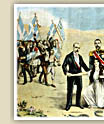
Two major theories developed in this period concerning the Great Idea, theories that led Greek foreign
policy in two different directions and representing two different views on national
integration: the Venizelist and the anti-Venizelist.
The former expressed the views of Greek nationalists and and nationalists of the New Territories annexed after the victorious Balkan Wars, whereas the latter
expressed the views of Old Greece.
Venizelism believed in the 'Greater Greece of the two continents and of the
five seas', with a distinctly nationalistic note, and projected the policy
that meant the expansion of the Greek territory and the inclusion
of Greek-speaking populations into the Greek state.
Anti-Venizelism opposes such expansionism, being all too aware of the sacrifices required for its
implementation. Instead, it proposed a 'small but honourable Greece', with reference
to the state before 1912. In the period 1916-17 the Schism, that was caused
by the disagreement of the leaders of the two blocs for the position
of Greece in the First World War, led to the creation of two states:
that of Athens and that of Thessaloniki.
The opposition of the two blocs, related to deeper socio-political contrasts in Greece
of that period, first became manifest upon the occasion of the dilemma that Greece had to face concerning her
position in the First World War, whereas later on it acquired a more tangible form in the personal conflict
between King Constantine and the Prime Minister Eleftherios Venizelos, divided the Greeks and led to the
crisis of the National Schism that culminated in the period 1916-17.
|
 |
